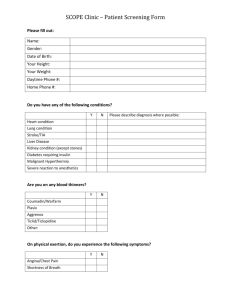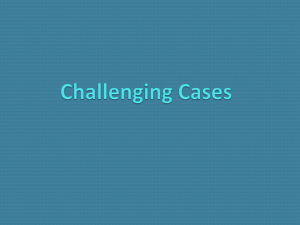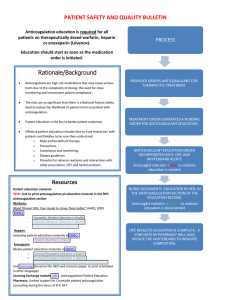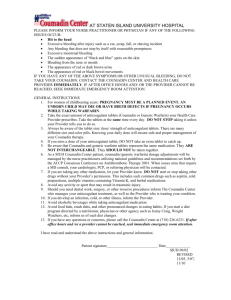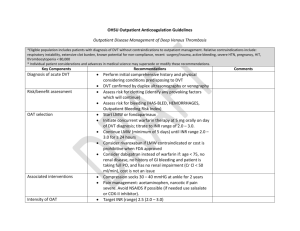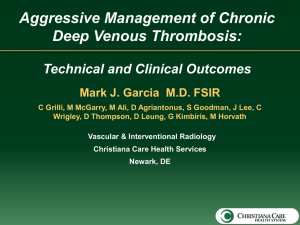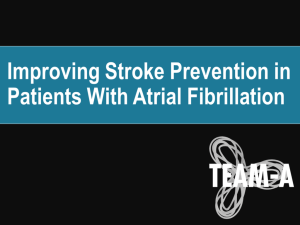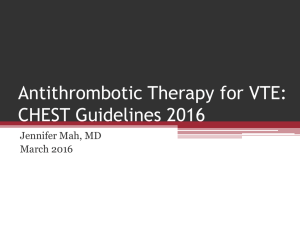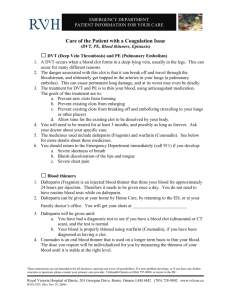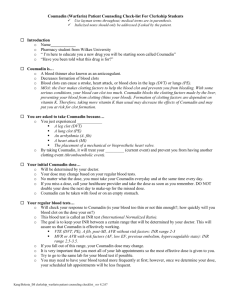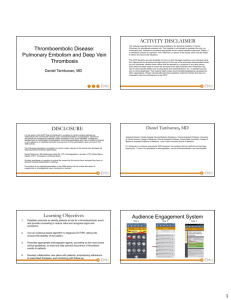Anticoagulation - What`s New in Medicine
advertisement
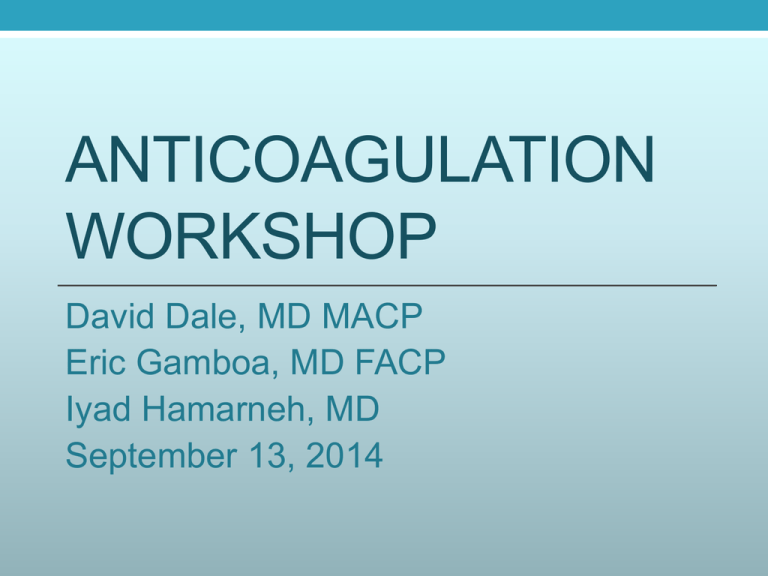
ANTICOAGULATION WORKSHOP David Dale, MD MACP Eric Gamboa, MD FACP Iyad Hamarneh, MD September 13, 2014 Case #1 51 year old male developed two unprovoked pulmonary emboli has been on warfarin for many years but was tired of the INR monitoring and diet restrictions his PCP referred him for opinion regarding switching to the new oral anticoagulants has mild renal insufficiency with GFR in the mid 50's ►How would you manage this patient? ►Is he a candidate for rivaroxaban? • Rivaroxaban is a direct factor Xa inhibitor • Approved for the treatment of VTE and nonvalvular atrial fibrillation • Usual dose is 20 mg daily • No dose reduction required for mild renal insufficiency • No specific antidote • NON-dialyzable • PCC has been shown to reverse anticoagulant effect in a small study (Eerenberg, et al. Circulation. 2011) Case #2 63 year old male has been on chronic warfarin for repeat episodes of VTE's attempts to discontinue anticoagulation by his PCP led to episodes of repeat thrombosis has been suffering from back pain and was noted to have disk herniation for which surgery has been recommended neurosurgeon consulted his hematologist/oncologist for the proper way to hold warfarin in the perioperative period in order to avoid bleeding but at the same time minimize possibility of thrombosing ► How would you advise interrupting warfarin? Case #3 78 year old female history of atrial fibrillation was on dabigatran developed gastric ulcer bleeding presented to the ER with continued bleeding, hypotension and severe anemia ►If you were consulted by the cardiologist and intensivist regarding management of bleeding, what would be your advice? • Dabigatran is a direct thrombin (factor IIa) inhibitor • Approved for the treatment of VTE and nonvalvular atrial fibrillation • Anticoagulant effect persists despite repletion of factor II (prothrombin) • Usual dose is 150 mg PO BID • No dose reduction required for mild renal insufficiency unless patient is on concomitant P-gp inhibitor • No specific antidote • Dialyzable • PCC did NOT reverse anticoagulant effect in a small study (Eerenberg, et al. Circulation. 2011) Case #4 67 year old female developed unprovoked DVT completed 6 months of warfarin therapy ►If you were asked by the PCP when and if warfarin can be stopped, what would be your advice? • 403 patients with a first-ever unprovoked VTE who • • • • completed 6-18 months of anticoagulation were randomized to receive aspirin 100 mg vs. placebo. Primary efficacy outcome was recurrence of VTE Secondary outcome was major bleeding Recurrent VTE occurred in 6.6% in the aspirin patients vs. 11.2% in the placebo patients (HR 0.58; 95% CI 0.330.92) Bleeding was the same in both groups Case #5 47 year old male history of a provoked DVT in 2005 (testicular trauma) underwent hypercoagulable work up which was positive for Lupus anticoagulant referred to rheumatology and subsequently diagnosed with SLE treated with plaquenil for 4 years until 2009 has been on Coumadin since 2005 No other episodes of DVTs Patient was sent to evaluate the need for further anticoagulation Coumadin was discontinued Weeks after stopping Coumadin he suffered flare of SLE with renal failure, proteinuria, pancytopenia and subsequently another episode of DVT ►What would you do now? Case #6 67 year old male history of unprovoked right LE DVT finished 10 months of anticoagulation with Coumadin no personal or family history of DVTs one of siblings tested positive for an MTHFR mutation PCP sent the patient for a hematology consult mostly for MTHFR testing and duration of anticoagulation ►Would you continue Coumadin? ►Would you test for MTHFR mutation? Case #7 26 year old female with multiple DVTs known to be heterozygous for Factor V Leiden and protein S deficiency has strong family history of Protein S deficiency and multiple DVTS on her father’s side of the family during her first pregnancy had DVT, no PE; treated with Lovenox for 6 weeks after delivery during second pregnancy had DVT with PE; treated with Lovenox and Coumadin. Duration of Coumadin unknown and stopped due to loosing her insurance during third pregnancy had PE; treated with Lovenox and Coumadin afterward for a total of 9 months. during pregnancy in August 2014 diagnosed with DVT while on 1.5 mg per kg of Lovenox. ►What would you do now? Case #8 62 year old male history of familial P.vera and DVT developed a PE after driving for 12 hours while on Coumadin INR was subtherapeutic at 1.4 he was switched to Lovenox after discharge from the hospital he was readmitted to the hospital with sepsis and acute renal failure was kept on the same dose of Lovenox DESPITE his declining renal function developed a large right knee hemarthrosis Lovenox was stopped and he was switched to heparin drip Hematology consult for anticoagulation after discharge GFR is ~ 15 ►What would you recommend now? Case #9 61 year old male prostate cancer and a history of provoked DVT on anticoagulation with Coumadin has large thoracic vertebral metastasis which was treated with radiation sustained a fall while working in the backyard which led to an ER visit in the ER was started on ketorolac 10 mg PO TID which helped with the pain 10 days after starting NSAIDS he presented with melena and was found to have erosive gastritis. ►What would you do now? References 1. Miller C, etal. Meta-analysis of efficacy and safety of new oral anticoagulants (dabigatran, rivaroxaban, apixaban) versus warfarin in patients with atrial fibrillation. Am J Cardiol. 2012;110:453-60 2. Becattini C, etal. Aspirin for preventing the recurrence of venous thromboembolism. N Engl J Med. 2012;366:1959-67 3. Eerenberg ES, etal. Reversal of rivaroxaban and dabigatran by prothrombin complex concentrate: a randomized, placebo-controlled, crossover study in healthy subjects. Circulation. 2011;124:1573-9 4. Guyatt GH, etal. Antithrombotic therapy and prevention of thrombosis, 9th ed: American College of Chest Physicians Evidence-Based Clinical Practice Guidelines Chest. 2012;141;7S-47S. 5. Imberti D, etal. Practical management of rivaroxaban for the treatment of venous thromboembolism. Clin Appl Thromb Hemost. 2013 Oct 16 [Epub ahead of print] 6. Kuderer NM, etal. Guidelines for treatment and prevention of venous thromboembolism among patients with cancer. Thromb Res. 2014;133 Suppl 2;S122-7
